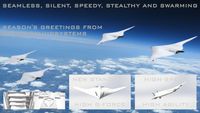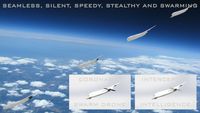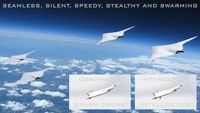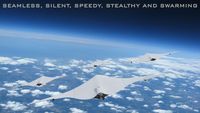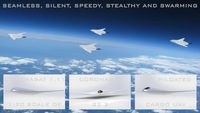Press Releases
Contact: Berkant GÖKSEL |
Press Release ELECTROFLUIDSYSTEMS SHOWS A PRESERIAL PROTOTYPE DESIGN OF A NEW MINI UAV FROM THE PLASMAFALCON CORONABAT SERIES. THE WHITE FALCON IS A HIGH-SPEED INTERCEPTOR AND ISR DRONE WITH ONBOARD DUAL ARTIFICIAL INTELLIGENCE (AI) AVIONICS, TRIPLE AUTOPILOT REDUNDANCY, DUAL RADIO, ACTIVE GPS JAMMING PROTECTION AND ONBOARD PLASMA FLOW CONTROL TECHNOLOGY. 21 December 2024 |
Worldwide, there is a new disruptive trend for fast interceptor drones based on modified, cost-effective off-the-shelf 2-4 kW RC helicopter motors which usually have a much higher revolution per minute (rpm) than standard brushless electric motors and can reach values even beyond 32,000 rpm. This enables now the use of small racing propellers with 8 to 12 inch (203 to 305 mm) diameter which would never produce enough speed and thrust with standard RC aircraft motors with rpm values usually going up to 16,000 only. That's the new hype. Today, most high-end mini and tactical UAVs have a cruise speed range from 50 to 100 km/h and can be easily attacked by fast flying FPV drones with 120 to 220 km/h. Now the latest models have even dash speeds of 300+ km/h and diving speeds of up to 450 km/h. And that's a serious threat for all high-end mini and even medium sized tactical UAVs. Extreme dash and diving speeds can even cause a serious threat for very expensive strategic UAVs. So we need a paradigm shift in drone design towards fast and sleek multi-role blended-wing-body aircrafts. With the CoronaBat UAV series Electrofluidsystems redefines the next generation of swarm-capable, highly maneurable, high-speed mini UAV systems for real-time surveillance assisted by the AES-256 encrypted Mesh Rider Dual Radio from Doodle Labs with a handheld high-end GCS controller based on the ruggedized and robust Panasonic FZ-S1. Cost-effective variants like the White Falcon Interceptor will use the Steam Deck or Herelink from CubePilot as drone controller. The CoronaBat UAS has two onboard DroneCore2 modules from Airvolute with the latest NVIDIA AI computer Jetson Orin NX. The dual artificial intelligence avionics will enable real-time optical navigation even in GNSS-denied environments. In any case the systems also integrates an active GPS jamming protection for two frequencies. For critical intelligence, surveillance and reconnaissance missions the dual AI system enables real-time object detection, tracking and classification. This is important for both the interceptor and intelligence variants. The main autopilot is based on the US-made hardware Cube Blue with ADS-B antenna from CubePilot and two additional Cube Blue units on the DroneCore2 modules for triple autopilot redundancy. The Cube Blue is identical to the Cube Orange with the main difference being that it is manufactured in the USA. The Cube Blue is designed for operators that require a US-made flight controller option, such as government or military operators. Be fast and still ultra-quiet. That's the way to fly in future with the new motto: Seamless, Silent, Speedy, Stealthy and Swarming to be Superior. |

